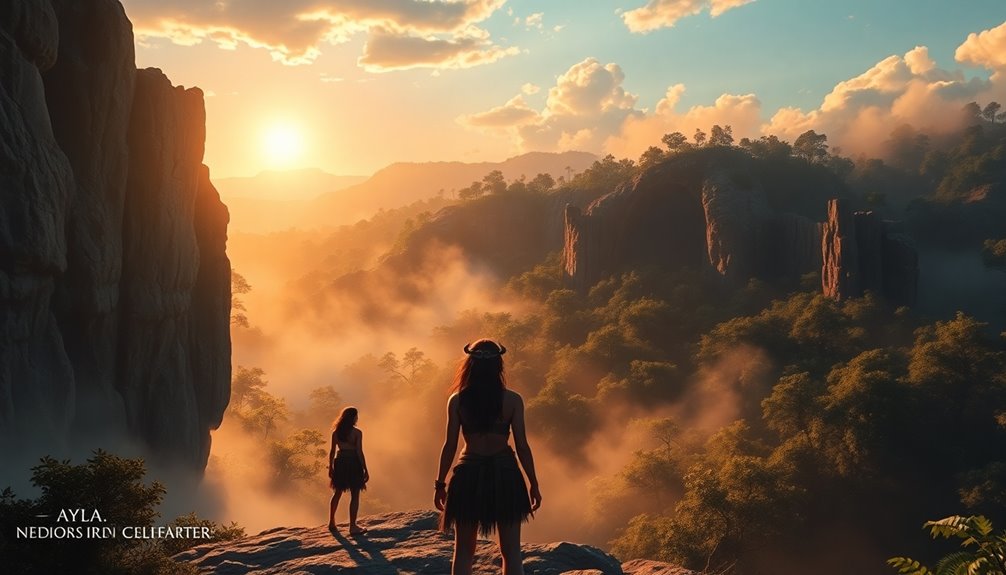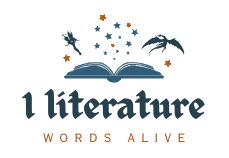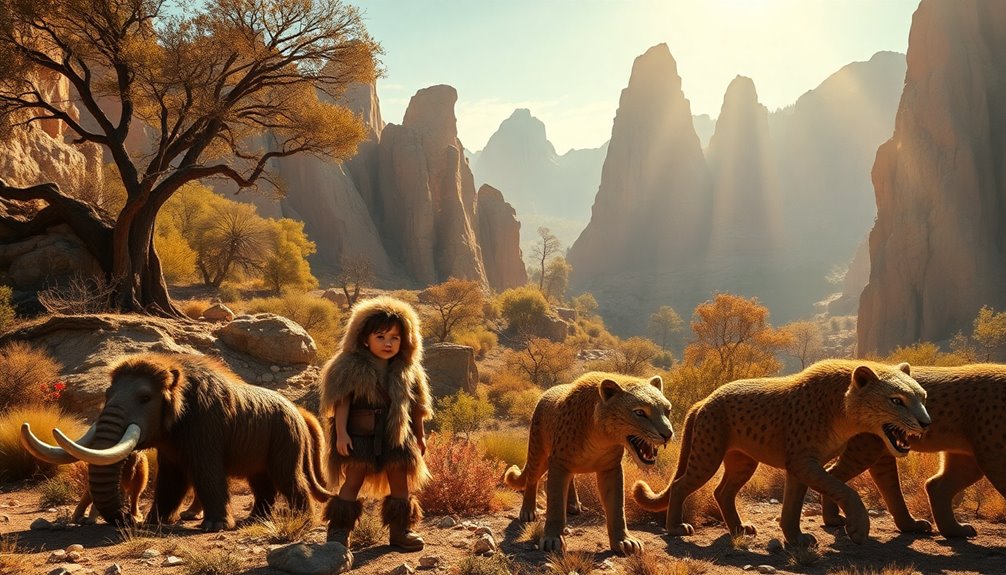In 'The Clan of the Cave Bear,' you'll explore an engaging representation of prehistoric life, following Ayla, a Cro-Magnon girl maneuvering her new life among Neanderthals. The novel highlights powerful themes like culture clash, identity struggle, and gender roles within a primitive society. You'll witness Ayla's resilience as she challenges the rigid social structures dictated by male dominance, particularly represented by the antagonist Broud. The rich character dynamics and emotional depth invite you to reflect on both historical contexts and contemporary implications. Stay with us, and you'll uncover even more intriguing insights into this groundbreaking work in prehistoric fiction.
Overview of the Novel

Often regarded as a groundbreaking work in prehistoric fiction, "The Clan of the Cave Bear" immerses you in the struggles of Ayla, a young Cro-Magnon girl maneuvering her new life with a group of Neanderthals after losing her family. Set during the Upper Paleolithic era, approximately 25,000 to 35,000 years ago, this novel captures the harsh realities of prehistoric life. The challenges faced by Ayla reflect the immigrant experience of adapting to new environments while striving for acceptance.
As Ayla adapts to her surroundings, you witness her unique abilities shine, setting her apart from the Clan. The cave's walls echo the challenges she faces as she navigates cultural differences and endeavors for acceptance among the Neanderthals. This narrative mirrors the courage and determination often displayed by women overcoming adversity in various forms.
Key characters like the nurturing Iza and the spiritual leader Creb play significant roles in her journey, while the antagonistic Broud symbolizes the traditional values that often clash with her Cro-Magnon identity.
Ayla's story isn't just about survival; it's about the struggle for identity amidst conflicting societal expectations. Themes of gender roles, cultural differences, and the quest for belonging are woven into this richly detailed narrative, making it a profound exploration of what it means to be human in a prehistoric world. Additionally, her journey mirrors the resilience often found in historical fiction books that feature strong female leads, showcasing how women can define their destinies against societal constraints.
Character Dynamics
In "The Clan of the Cave Bear," you witness Ayla's struggle for acceptance among the Neanderthals, which reveals the intense power dynamics within the Clan.
Iza's nurturing influence stands in stark contrast to Broud's antagonism, showcasing the complex relationships that shape Ayla's journey. The character dynamics also illustrate the ways in which systemic oppression can influence personal relationships and individual identity. Moreover, the portrayal of Ayla's resilience reflects the spirit of unsung contributions made by those who challenge societal norms and strive for acceptance.
As you explore these character dynamics, you'll see how compassion and rivalry intertwine, reflecting broader themes of identity and cultural clash.
Additionally, the novel's exploration of class struggles mirrors the societal challenges faced by characters in Dickens' works, emphasizing the timeless nature of such conflicts.
Ayla's Struggle for Acceptance
Acceptance is a powerful theme in 'The Clan of the Cave Bear,' particularly as it unfolds through Ayla's character dynamics. As a Cro-Magnon orphan, you see Ayla grappling with her identity amidst the rigid social structures of the Clan. Her advanced cognitive skills and physical agility set her apart, making her a target for misunderstanding and isolation.
Despite Iza's nurturing, Ayla feels the weight of traditional gender roles that confine her, especially in her interactions with Broud, the Clan leader's son. He embodies the patriarchal values that reject her individuality, often antagonizing her for simply being different.
However, Ayla's resilience shines through her relationship with Creb, the Clan's shaman. He acts as a mentor, guiding her through the complexities of Clan life, helping her navigate acceptance despite the prevailing resistance.
The emotional dynamics between Ayla and the Clan members expose her struggles but also illustrate her determination to forge a place for herself. Through her journey, Ayla challenges the Clan's norms, ultimately embracing her unique identity and redefining what it means to belong.
Power Dynamics in Clan
The Clan's power dynamics are a complex web of relationships shaped by rigid gender roles and social hierarchies. Within this structure, male members like Broud exert dominance, often clashing with Ayla, who embodies individuality. Her presence challenges the Clan's traditional norms, highlighting the tension between conformity and unique abilities.
Key elements defining these dynamics include:
- Rigid Gender Roles: Males dominate decision-making, while females are often relegated to submissive roles.
- Social Hierarchy: The Clan's hierarchy favors established members, making it hard for outsiders like Ayla to gain acceptance.
- Conflict and Control: Broud's antagonism towards Ayla symbolizes the struggle between tradition and innovation.
- Mentorship: Creb, the shaman, acts as a bridge, recognizing Ayla's potential and offering guidance despite the clan's male-centric views.
Ayla's journey illustrates how adaptability and resilience can disrupt entrenched power dynamics. As she navigates the Clan's social hierarchy, her unique skills gradually earn her a place, signifying a shift in traditional authority.
This evolution suggests that breaking free from rigid gender roles can lead to a more dynamic and inclusive social structure.
Iza's Nurturing Influence
While Ayla faces hostility from the Clan's rigid hierarchy, Iza emerges as a vital figure in her journey. As the Clan's medicine woman, Iza nurtures Ayla back to health after the devastating earthquake that takes her family. This act of kindness is just the beginning of their deep bond.
Iza teaches Ayla essential skills, like herbal medicine and healing practices, which not only help her survive but also integrate into the Clan's world.
Iza's nurturing nature starkly contrasts with the initial resistance Ayla encounters. Through Iza, you see a beacon of compassion, highlighting the potential for empathy across cultural divides. This relationship emphasizes the importance of maternal love and mentorship in Ayla's growth.
Iza's acceptance of Ayla reinforces the themes of survival and identity that permeate the novel.
Ultimately, Iza's influence serves as a bridge, connecting Ayla to the Clan while providing her with the tools to navigate her challenging new environment.
Their relationship illustrates how nurturing connections can foster resilience, making Iza a significant character in Ayla's journey toward acceptance and self-discovery.
Themes and Motifs

In "The Clan of the Cave Bear," you see how Ayla's journey highlights her struggle for identity and belonging among the Neanderthals.
The story challenges traditional gender roles, showcasing her resistance against societal expectations. This resistance can be likened to the themes of perseverance and determination found in Louis Zamperini's survival story from WWII. Additionally, her quest reflects the ongoing power dynamics in marriage, as she navigates the complexities of relationships and seeks to assert her independence, echoing the concept of gender roles in marital relationships.
As you explore these themes, you'll notice how they shape Ayla's relationships and her quest for acceptance. Additionally, the narrative reflects on the importance of faith and perseverance, which parallels the emotional journeys found in contemporary Christian romance novels.
Identity and Belonging
Ayla's struggle for identity and belonging drives much of the narrative in 'The Clan of the Cave Bear.' As she confronts the challenges of being a Cro-Magnon in a Neanderthal Clan, you see her resilience and innovative spirit clash with the rigid traditions of her new community. This cultural clash creates a poignant backdrop for her quest to find acceptance.
Throughout the story, you witness how emotional bonds help Ayla navigate her outsider status. Key elements that shape her journey include:
- The perception of 'the Others': Ayla's identity is constantly scrutinized as she's seen as different.
- Innovative skills: Her resourcefulness challenges Clan norms, highlighting her quest for belonging.
- Relationships with Iza and Creb: These connections foster understanding and acceptance, contrasting with the Clan's rigid views.
- Broud's antagonism: His hostility represents the societal pressures that complicate Ayla's integration.
Ultimately, Ayla's journey is a powerful exploration of identity and belonging, showcasing the emotional bonds that can both uplift and challenge an individual in a world steeped in tradition.
Gender Roles and Power
The Clan of the Cave Bear vividly illustrates how gender roles shape power dynamics within its prehistoric society. In this world, men dominate, reinforcing traditional societal norms that dictate their authority and influence. Ayla, however, challenges these conventions through her resilience and resourcefulness. Her innovative thinking sets her apart, reflecting a struggle against the rigid expectations imposed by her Clan.
The tension between Ayla and Broud epitomizes the conflict surrounding gender roles. Broud, representing male dominance, embodies the traditional values that stifle Ayla's potential. Their antagonistic relationship highlights the complexities of power dynamics in a patriarchal society, where strength is often equated with gender.
As you read, you'll notice how Ayla's journey critiques these established norms. Her ability to transcend societal limitations invites you to contemplate the implications of such roles, not just in the past but in contemporary life as well.
The narrative suggests that strength and capability aren't confined to gender, urging you to reflect on the resilience found in embracing individuality over conformity. Ultimately, the story challenges you to question how power can be redefined in the face of oppressive societal structures.
Historical Context
Set against the backdrop of the Upper Paleolithic era, "The Clan of the Cave Bear" immerses you in a world where Cro-Magnon humans and Neanderthals coexist approximately 25,000 to 35,000 years ago.
This historical fiction novel provides a fascinating exploration of prehistoric Europe, highlighting the intricate dynamics between these two human species.
Jean M. Auel's extensive research brings authenticity to the narrative, showcasing:
- The cultural and cognitive differences in communication and social structures.
- The impact of natural events, like the earthquake that alters Ayla's life.
- The adaptability of human societies in facing adversity and their ability to survive in harsh environments, which mirrors the resilience found in modern narratives. Education serves as a crucial tool for overcoming adversity and fostering resilience in both prehistoric and contemporary contexts.
- A challenge to common perceptions of Neanderthals' roles in their communities.
Additionally, the themes of collective action resonate with the resilience and unity displayed by early human societies as they navigated their harsh environments.
Film Adaptation Comparison

Exploring the historical context of "The Clan of the Cave Bear" sets the stage for understanding its film adaptation. The 1986 film, while based on Jean Auel's best-known work, takes notable liberties. It presents Neanderthals in a more positive light, challenging stereotypes that often portray them as brutish.
However, this adaptation sacrifices emotional depth and complexity, resulting in a simplified portrayal of character interactions that doesn't fully capture Auel's intricate narrative. The film's representation of Neanderthal society can be seen as a form of resistance against stereotypes, similar to how small acts of defiance can challenge prevailing narratives. Additionally, the film overlooks the nuances of co-dependent relationships that are critical in the novel's character development.
Key scenes from the novel, including the thrilling mammoth hunts, are absent in the film due to budget constraints and technical challenges. This omission affects the film's ability to immerse you in prehistoric life.
While the adaptation succeeds in prompting viewers to rethink preconceived notions about Neanderthal society, it falls short in presenting the rich character development that makes Auel's work compelling. The film also lacks the psychological tension that drives the characters' emotional arcs in the novel.
Despite these shortcomings, the film serves as an invitation to revisit the novel. It encourages you to explore the deeper themes and character dynamics that the adaptation glosses over, offering a contrasting interpretation of the prehistoric narrative.
The film may entertain, but the book reveals the true emotional journey of its characters.
Reader Reception and Recommendations
With its mix of praise and criticism, "The Clan of the Cave Bear" has sparked a range of reactions from readers. You'll find ratings from 0.5 to 5.0, showcasing the book's polarizing nature. Many readers appreciate the character development, particularly Ayla's resilience and complexity, while others feel the pacing drags at times.
Emotional responses are significant, especially regarding themes of strength and oppression. Ayla's journey of empowerment resonates deeply with many, making the narrative impactful.
Here are some key points to reflect on:
- Character Development: Ayla's growth throughout the story is a highlight.
- Emotional Responses: The themes of strength and oppression evoke strong feelings.
- Historical Accuracy: The book's attention to prehistoric details enhances its appeal.
- Recommended Read: It's a must-read for those intrigued by prehistoric life.
While the film adaptation offers entertainment, it often misses the depth of the novel. For a fuller understanding of the characters and themes, diving into the book is highly encouraged.
Whether you love it or not, it's clear that "The Clan of the Cave Bear" leaves a lasting impression.
Conclusion
In "The Clan of the Cave Bear," you journey through a vivid world where survival and humanity intertwine like the roots of ancient trees. You feel the chill of the Ice Age, hear the whispers of ancestral spirits, and witness the struggle for identity amidst harsh realities. As you close the book, the echoes of Ayla's resilience linger, urging you to reflect on your own place in the tapestry of life, where every thread tells a story worth exploring.



